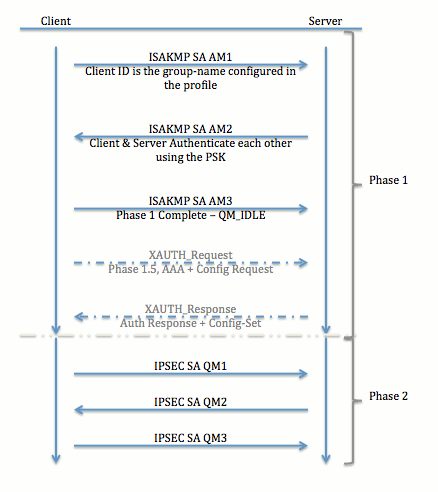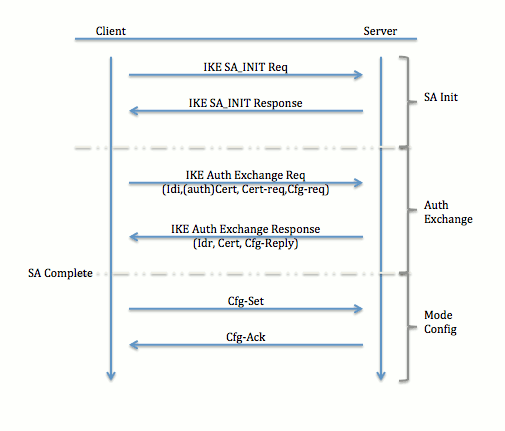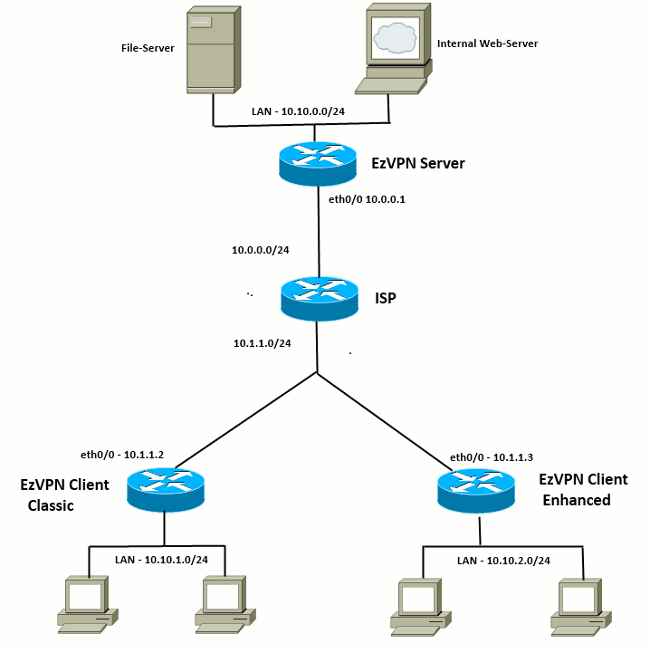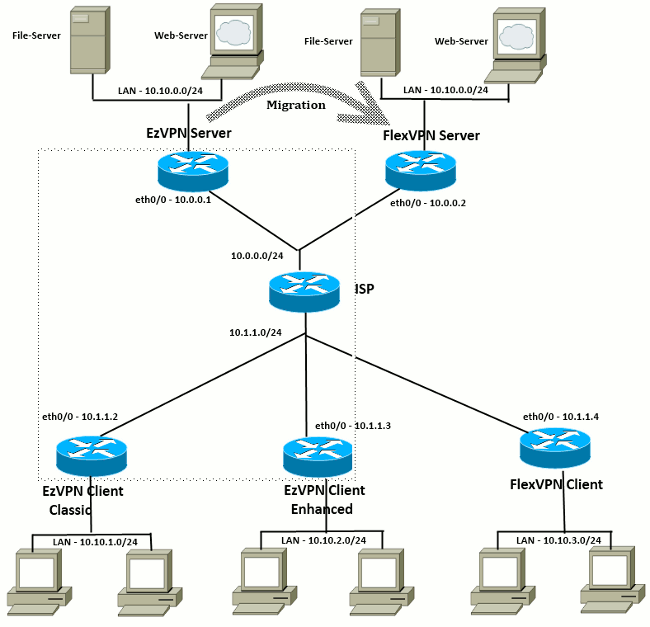EzVPN-NEM에서 FlexVPN으로 마이그레이션 가이드
목차
소개
이 문서에서는 EzVPN(Internet Key Exchange v1(IKEv1) 설정에서 FlexVPN(IKEv2) 설정으로의 마이그레이션 프로세스에 대해 가능한 한 적은 수의 문제를 지원합니다. IKEv2 Remote Access는 마이그레이션이 다소 어려운 특정 방식으로 IKEv1 Remote Access와 다르기 때문에 이 문서에서는 EzVPN 모델에서 FlexVPN Remote Access 모델로 마이그레이션할 때 다양한 설계 방식을 선택할 수 있습니다.
이 문서는 IOS FlexVPN 클라이언트 또는 하드웨어 클라이언트를 다룹니다. 이 문서에서는 소프트웨어 클라이언트에 대해 다루지 않습니다. 소프트웨어 클라이언트에 대한 자세한 내용은 다음을 참조하십시오.
사전 요구 사항
요구 사항
다음 주제에 대한 지식을 보유하고 있으면 유용합니다.
-
IKEv2
-
Cisco FlexVPN
-
Cisco AnyConnect Secure Mobility Client
-
Cisco VPN 클라이언트
사용되는 구성 요소
이 문서는 특정 소프트웨어 및 하드웨어 버전으로 한정되지 않습니다.
이 문서의 정보는 특정 랩 환경의 디바이스를 토대로 작성되었습니다. 이 문서에 사용된 모든 디바이스는 초기화된(기본) 컨피그레이션으로 시작되었습니다. 현재 네트워크가 작동 중인 경우, 모든 명령어의 잠재적인 영향을 미리 숙지하시기 바랍니다.
표기 규칙
문서 규칙에 대한 자세한 내용은 Cisco 기술 팁 표기 규칙을 참고하십시오.
EzVPN 대 FlexVPN
EzVPN 모델 - 눈에 띄는 요소
이름에서 알 수 있듯이 EzVPN의 목적은 원격 클라이언트의 VPN 구성을 쉽게 만드는 것입니다. 이를 위해 클라이언트는 클라이언트 프로필이라고도 하는 올바른 EzVPN 서버에 연결하는 데 필요한 최소한의 세부 정보로 구성됩니다.
터널 협상

FlexVPN Remote Access VPN 모델
FlexVPN 서버
일반 FlexVPN과 FlexVPN Remote Access 설정 간의 중요한 차이점은 서버가 RSA-SIG(pre-shared key and certificates) 방법만 사용하여 FlexVPN 클라이언트에 자신을 인증해야 한다는 것입니다. FlexVPN을 사용하면 initiator와 responder가 서로 독립적으로 어떤 인증 방법을 사용할지 결정할 수 있습니다. 즉, 동일하거나 다를 수 있습니다. 그러나 FlexVPN Remote Access의 경우 서버에 선택 사항이 없습니다.
IOS FlexVPN 클라이언트 인증 방법
클라이언트는 다음 인증 방법을 지원합니다.
-
RSA-SIG — 디지털 인증서 인증.
-
사전 공유 — 사전 공유 키(PSK) 인증.
-
EAP(Extensible Authentication Protocol) - EAP 인증. IOS FlexVPN 클라이언트에 대한 EAP-Support가 15.2(3)T에 추가되었습니다.
IOS FlexVPN 클라이언트에서 지원되는 EAP 방법은 다음과 같습니다.
-
확장 가능 한 인증 프로토콜 메시지 다이제스트 5 (EAP-MD5),
-
Extensible Authentication Protocol-Microsoft Challenge Handshake Authentication Protocol 버전 2(EAP-MSCHAPv2) 및
-
EAP-GTC(Extensible Authentication Protocol-Generic Token Card).
-
이 문서에서는 다음과 같은 이유로 RSA-SIG 인증 사용에 대해서만 설명합니다.
-
확장성 — 각 클라이언트에는 인증서가 부여되며, 서버에서 클라이언트 ID의 일반 부분이 인증됩니다.
-
보안 — 와일드카드 PSK보다 더 안전합니다(로컬 권한 부여의 경우). AAA(인증, 권한 부여 및 어카운팅) 권한 부여의 경우 잘못된 IKE ID를 기반으로 별도의 PSK를 작성하는 것이 더 쉽습니다.
이 문서에 나와 있는 FlexVPN 클라이언트 컨피그레이션은 EasyVPN 클라이언트에 비해 약간 완전한 것 같습니다. 이는 컨피그레이션에 스마트 기본값으로 인해 사용자가 구성할 필요가 없는 일부 컨피그레이션이 포함되어 있기 때문입니다. 스마트 기본값은 제안, 정책, IPSec 변형 집합 등의 다양한 항목에 대해 사전 구성되거나 기본 구성을 참조하는 데 사용되는 용어입니다. IKEv1 기본값과 달리 IKEv2 스마트 기본값은 강합니다. 예를 들어 제안서에서 Advanced Encryption Standard(AES-256), Secure Hash Algorithm(SHA-512), Group-5 등을 사용합니다.
터널 협상

IKEv2 교환을 위한 패킷 교환에 대한 자세한 내용은 IKEv2 패킷 교환 및 프로토콜 수준 디버깅을 참조하십시오.
초기 설정
토폴로지

초기 컨피그레이션
EzVPN 허브 - dVTI 기반
!! AAA Config for EzVPN clients. We are using Local AAA Server. aaa new-model aaa authentication login default local aaa authorization network default local !! ISAKMP Policy crypto isakmp policy 1 encr 3des authentication pre-share group 2 !! ISAKMP On-Demand Keep-Alive crypto isakmp keepalive 10 2 !! EzVPN Split ACL access-list 101 permit ip 10.10.0.0 0.0.0.255 any !! EzVPN Client Group Configuration. This is what holds all the config attributes crypto isakmp client configuration group cisco key cisco dns 6.0.0.2 wins 7.0.0.1 domain cisco.com acl 101 save-password !! ISAKMP Profile. This ties Client IKE identity to AAA. !! And since this is dVTI setup, ISAKMP Profile tells the IOS !! from which Virtual-Template (VT1) to clone the Virtual Access interfaces crypto isakmp profile vi match identity group cisco client authentication list default isakmp authorization list default virtual-template 1 !! IPSec Transform Set. crypto ipsec transform-set set esp-3des esp-sha-hmac !! IPSec Profile. This ties Transform set and ISAKMP Profile together. crypto ipsec profile vi set transform-set set set isakmp-profile vi !! The loopback interface. And virtual-template borrows the address from here. interface Loopback0 ip address 10.10.10.1 255.255.255.252 !! dVTI interface. interface Virtual-Template1 type tunnel ip unnumbered Loopback0 tunnel mode ipsec ipv4 tunnel protection ipsec profile vi
EzVPN 클라이언트 - 클래식(VTI 없음)
!! ISAKMP On-Demand Keep-Alive crypto isakmp keepalive 10 2 !! EzVPN Client - Group Name and The key (as configured on the Server), !! Peer address and XAUTH config go here. crypto ipsec client ezvpn ez connect auto group cisco key cisco local-address Ethernet0/0 mode network-extension peer 10.0.0.1 username cisco password cisco xauth userid mode local !! EzVPn outside interface - i.e. WAN interface interface Ethernet0/0 ip address 10.1.1.2 255.255.255.0 crypto ipsec client ezvpn ez !! EzVPN inside interface !! Traffic sourced from this LAN is sent over established Tunnel interface Ethernet0/1 ip address 10.10.1.1 255.255.255.0 crypto ipsec client ezvpn ez inside
EzVPN 클라이언트 - 고급(VTI 기반)
!! VTI - interface Virtual-Template1 type tunnel no ip address tunnel mode ipsec ipv4 !! ISAKMP On-Demand Keep-Alive crypto isakmp keepalive 10 2 !! EzVPN Client - Group Name and The key (as configured on the Server), !! Peer address and XAUTH config go here. !! Also this config says which Virtual Template to use. crypto ipsec client ezvpn ez connect auto group cisco key cisco local-address Ethernet0/0 mode network-extension peer 10.0.0.1 virtual-interface 1 username cisco password cisco xauth userid mode local !! EzVPn outside interface - WAN interface interface Ethernet0/0 ip address 10.1.1.3 255.255.255.0 crypto ipsec client ezvpn ez !! EzVPN inside interface - !! Traffic sourced from this LAN is sent over established Tunnel interface Ethernet0/1 ip address 10.10.2.1 255.255.255.0 crypto ipsec client ezvpn ez inside
EzVPN에서 FlexVPN으로의 마이그레이션 접근 방식
EzVPN 서버 역할을 하는 서버는 IKEv2 원격 액세스 컨피그레이션을 지원하는 한 FlexVPN 서버 역할을 할 수도 있습니다. 전체 IKEv2 컨피그레이션을 지원하려면 IOS v15.2(3)T를 초과하는 모든 것이 권장됩니다. 이 예에서는 15.2(4)M1이 사용되었습니다.
두 가지 방법이 있습니다.
-
EzVPN 서버를 FlexVPN 서버로 설정한 다음 EzVPN 클라이언트를 Flex 구성으로 마이그레이션합니다.
-
다른 라우터를 FlexVPN 서버로 설정합니다. EzVPN 클라이언트 및 마이그레이션된 FlexVPN 클라이언트는 FlexVPN 서버와 EzVPN 서버 간의 연결을 생성하여 계속 통신합니다.
이 문서에서는 두 번째 접근 방식을 설명하고 새 스포크(예: Spoke3)를 FlexVPN 클라이언트로 사용합니다. 이 스포크는 나중에 다른 클라이언트를 마이그레이션하기 위해 참조로 사용할 수 있습니다.
마이그레이션 단계
EzVPN 스포크에서 FlexVPN 스포크로 마이그레이션할 때 EzVPN 스포크에서 FlexVPN 구성을 로드하도록 선택할 수 있습니다. 그러나 컷오버 과정에서 해당 장비에 대한 아웃오브밴드(non-VPN) 관리 액세스가 필요할 수 있습니다.
마이그레이션된 토폴로지

구성
FlexVPN 허브
!! AAA Authorization done Locally aaa new-model aaa authorization network Flex local !! PKI TrustPoint to Sign and Validate Certificates. !! Contains Identity Certificate and CA Certificate crypto pki trustpoint FlexServer enrollment terminal revocation-check none rsakeypair FlexServer subject-name CN=flexserver.cisco.com,OU=FlexVPN !! Access-list used in Config-Reply in order to push routes access-list 1 permit 10.10.0.0 0.0.0.255 !! IKEv2 Authorization done locally. Used in Config-Set. crypto ikev2 authorization policy FlexClient-Author def-domain cisco.com route set interface route set access-list 1 !! IKEv2 Proposal. Optional Config. Smart-Default takes care of this. crypto ikev2 proposal FlexClient-Proposal encryption aes-cbc-128 aes-cbc-192 3des integrity sha256 sha512 sha1 group 5 2 !! If IKEv2 Proposal was left out default, then IKEv2 Policy can be left out too. !! Ties Proposal to Peer address/fvrf crypto ikev2 policy FlexClient-Policy match fvrf any proposal FlexClient-Proposal !! IKEv2 Profile. This is the main Part !! Clients are configured to send their FQDN. And we match the domain 'cisco.com' !! We are sending 'flexserver.cisco.com' as the fqdn identity. !! Local and Remote authentication is RSA-SIG !! Authorization (config-reply) is done locally with the user-name !! 'FlexClient-Author' !! This whole profile is tied to Virtual-Template 1 crypto ikev2 profile FlexClient-Profile match identity remote fqdn domain cisco.com identity local fqdn flexserver.cisco.com authentication remote rsa-sig authentication local rsa-sig pki trustpoint FlexServer aaa authorization group cert list Flex FlexClient-Author virtual-template 1 !! IPSec Transform set. Optional Config, since Smart Default takes care of this. crypto ipsec transform-set ESP-AES-SHA1 esp-aes esp-sha-hmac !! IPSec Profile ties default/Configured transform set with the IKEv2 Profile crypto ipsec profile FlexClient-IPSec set transform-set ESP-AES-SHA1 set ikev2-profile FlexClient-Profile !! Loopback interface lends ip address to Virtual-template and !! eventually to Virtual-Access interfaces spawned. interface Loopback0 ip address 10.10.10.1 255.255.255.252 !! The IKEv2 enabled Virtual-Template interface Virtual-Template1 type tunnel ip unnumbered Loopback0 tunnel protection ipsec profile FlexClient-IPSec !! WAN interface interface Ethernet0/0 ip address 10.0.0.2 255.255.255.0 !! LAN interfaces interface Ethernet0/1 ip address 10.10.0.1 255.255.255.0
서버 인증서 참고 사항
KU(Key Usage)는 공개 키의 용도 또는 용도를 정의합니다. EKU(Enhanced/Extended Key Usage)는 키 사용을 수정합니다. FlexVPN을 사용하려면 클라이언트에서 인증서를 승인하려면 서버 인증서에 디지털 서명 및 키 암호화의 KU 특성이 있는 서버 인증(OID = 1.3.6.1.5.5.7.3.1)의 EKU가 있어야 합니다.
FlexServer#show crypto pki certificates verbose
Certificate
Status: Available
Version: 3
Certificate Serial Number (hex): 09
Certificate Usage: General Purpose
Issuer:
l=lal-bagh
c=IN
o=Cisco
ou=TAC
cn=Praveen
Subject:
Name: flexserver.cisco.com
ou=FlexVPN
cn=flexserver.cisco.com
CRL Distribution Points:
http://10.48.67.33:80/Praveen/Praveen.crl
<snip>
Signature Algorithm: MD5 with RSA Encryption
Fingerprint MD5: F3646C9B 1CC26A81 C3CB2034 061302AA
Fingerprint SHA1: 7E9E99D4 B66C70E3 CBA8C4DB DD94629C 023EEBE7
X509v3 extensions:
X509v3 Key Usage: E0000000
Digital Signature
Non Repudiation
Key Encipherment
<snip>
Authority Info Access:
Extended Key Usage:
Client Auth
Server Auth
Associated Trustpoints: FlexServer
Storage: nvram:lal-bagh#9.cer
Key Label: FlexServer
Key storage device: private config
CA Certificate
<snip>
FlexVPN 클라이언트 컨피그레이션
!! AAA Authorization done Locally aaa new-model aaa authorization network Flex local !! PKI TrustPoint to Sign and Validate Certificates. !! Contains Identity Certificate and CA Certificate crypto pki trustpoint Spoke3-Flex enrollment terminal revocation-check none subject-name CN=spoke3.cisco.com,OU=FlexVPN rsakeypair Spoke3-Flex !! Access-list used in Config-Set in order to push routes access-list 1 permit 10.10.3.0 0.0.0.255 !! IKEv2 Authorization done locally. Used in Config-Set. crypto ikev2 authorization policy FlexClient-Author route set interface route set access-list 1 !! IKEv2 Proposal. Optional Config. Smart-Default takes care of this. crypto ikev2 proposal FlexClient-Proposal encryption aes-cbc-128 aes-cbc-192 3des integrity sha256 sha512 sha1 group 5 2 !! If IKEv2 Proposal was left out default, then IKEv2 Policy can be left out too. !! Ties Proposal to Peer address/fvrf crypto ikev2 policy FlexClient-Policy match fvrf any proposal FlexClient-Proposal !! IKEv2 Profile. This is the main Part !! Server is configured to send its FQDN type IKE-ID, !! and we match the domain 'cisco.com' !! (If the IKE-ID type is DN (extracted from the certificate), !! we will need a certificate map) !! We are sending 'spoke3.cisco.com' as the IKE-identity of type fqdn. !! Local and Remote authentication is RSA-SIG !! Authorization (config-set) is done locally using the user-name filter !! 'FlexClient-Author' crypto ikev2 profile FlexClient-Profile match identity remote fqdn flexserver.cisco.com identity local fqdn spoke3.cisco.com authentication remote rsa-sig authentication local rsa-sig pki trustpoint Spoke3-Flex aaa authorization group cert list Flex FlexClient-Author !! IPSec Transform set. Optional Config, since Smart Default takes care of this. crypto ipsec transform-set ESP-AES-SHA1 esp-aes esp-sha-hmac !! IPSec Profile ties the transform set with the IKEv2 Profile crypto ipsec profile FlexClient-IPSec set transform-set ESP-AES-SHA1 set ikev2-profile FlexClient-Profile !! FlexVPN Client Tunnel interface. !! If IP-Address of the tunnel is negotiated, !! FlexVPN server is capable of assigning an IP through Config-Set interface Tunnel0 ip unnumbered Ethernet0/1 tunnel source Ethernet0/0 tunnel destination dynamic tunnel protection ipsec profile FlexClient-IPSec !! Final FlexVPN client Part. !! Multiple backup Peer and/or Multiple Tunnel source interfaces can be configured crypto ikev2 client flexvpn FlexClient peer 1 10.0.0.2 client connect Tunnel0 !! WAN interface interface Ethernet0/0 ip address 10.1.1.4 255.255.255.248 !! LAN Interface interface Ethernet0/1 ip address 10.10.3.1 255.255.255.0
클라이언트 인증서 참고 사항
FlexVPN을 사용하려면 서버에서 인증서를 승인하려면 클라이언트 인증서에 디지털 서명 및 키 암호화의 KU 특성이 있는 클라이언트 인증(OID = 1.3.6.1.5.5.7.3.2)의 EKU가 있어야 합니다.
Spoke3#show crypto pki certificates verbose
Certificate
Status: Available
Version: 3
Certificate Serial Number (hex): 08
Certificate Usage: General Purpose
Issuer:
l=lal-bagh
c=IN
o=Cisco
ou=TAC
cn=Praveen
Subject:
Name: spoke3.cisco.com
ou=FlexVPN
cn=spoke3.cisco.com
<snip>
Subject Key Info:
Public Key Algorithm: rsaEncryption
RSA Public Key: (1024 bit)
Signature Algorithm: MD5 with RSA Encryption
Fingerprint MD5: 2381D319 906177E1 F45019BC 61059BD5
Fingerprint SHA1: D81FD705 653547F2 D0916710 E6B096A1 23F6C467
X509v3 extensions:
X509v3 Key Usage: E0000000
Digital Signature
Non Repudiation
Key Encipherment
<snip>
Extended Key Usage:
Client Auth
Server Auth
Associated Trustpoints: Spoke3-Flex
Storage: nvram:lal-bagh#8.cer
Key Label: Spoke3-Flex
Key storage device: private config
CA Certificate
<snip>
FlexVPN 작업 확인
FlexVPN 서버
FlexServer#show crypto ikev2 session
IPv4 Crypto IKEv2 Session
Session-id:5, Status:UP-ACTIVE, IKE count:1, CHILD count:1
Tunnel-id Local Remote fvrf/ivrf Status
1 10.0.0.2/500 10.1.1.4/500 none/none READY
Encr: AES-CBC, keysize: 192, Hash: SHA512, DH Grp:5, Auth sign: RSA, Auth verify:
RSA
Life/Active Time: 86400/7199 sec
Child sa: local selector 10.0.0.2/0 - 10.0.0.2/65535
remote selector 10.1.1.4/0 - 10.1.1.4/65535
ESP spi in/out: 0xA9571C00/0x822DDAAD
FlexServer#show crypto ikev2 session detailed
IPv4 Crypto IKEv2 Session
Session-id:5, Status:UP-ACTIVE, IKE count:1, CHILD count:1
Tunnel-id Local Remote fvrf/ivrf Status
1 10.0.0.2/500 10.1.1.4/500 none/none READY
Encr: AES-CBC, keysize: 192, Hash: SHA512, DH Grp:5, Auth sign: RSA, Auth verify:
RSA
Life/Active Time: 86400/7244 sec
CE id: 1016, Session-id: 5
Status Description: Negotiation done
Local spi: 648921093349609A Remote spi: 1C2FFF727C8EA465
Local id: flexserver.cisco.com
Remote id: spoke3.cisco.com
Local req msg id: 2 Remote req msg id: 5
Local next msg id: 2 Remote next msg id: 5
Local req queued: 2 Remote req queued: 5
Local window: 5 Remote window: 5
DPD configured for 0 seconds, retry 0
NAT-T is not detected
Cisco Trust Security SGT is disabled
Initiator of SA : No
Remote subnets:
10.10.3.0 255.255.255.0
Child sa: local selector 10.0.0.2/0 - 10.0.0.2/65535
remote selector 10.1.1.4/0 - 10.1.1.4/65535
ESP spi in/out: 0xA9571C00/0x822DDAAD
AH spi in/out: 0x0/0x0
CPI in/out: 0x0/0x0
Encr: AES-CBC, keysize: 128, esp_hmac: SHA96
ah_hmac: None, comp: IPCOMP_NONE, mode transport
FlexServer#show ip route static
10.0.0.0/8 is variably subnetted, 9 subnets, 4 masks
S 10.10.3.0/30 is directly connected, Virtual-Access1
FlexServer#ping 10.10.3.1 repeat 100
Type escape sequence to abort.
Sending 100, 100-byte ICMP Echos to 10.10.3.1, timeout is 2 seconds:
!!!!!!!!!!!!!!!!!!!!!!!!!!!!!!!!!!!!!!!!!!!!!!!!!!!!!!!!!!!!!!!!!!!!!!
!!!!!!!!!!!!!!!!!!!!!!!!!!!!!!
Success rate is 100 percent (100/100), round-trip min/avg/max = 1/5/13 ms
FlexServer#show crypto ipsec sa | I ident|caps|spi
local ident (addr/mask/prot/port): (10.0.0.2/255.255.255.255/47/0)
remote ident (addr/mask/prot/port): (10.1.1.4/255.255.255.255/47/0)
#pkts encaps: 205, #pkts encrypt: 205, #pkts digest: 205
#pkts decaps: 200, #pkts decrypt: 200, #pkts verify: 200
current outbound spi: 0x822DDAAD(2184043181)
spi: 0xA9571C00(2841058304)
spi: 0x822DDAAD(2184043181)
FlexVPN 원격
Spoke3#show crypto ikev2 session
IPv4 Crypto IKEv2 Session
Session-id:4, Status:UP-ACTIVE, IKE count:1, CHILD count:1
Tunnel-id Local Remote fvrf/ivrf Status
1 10.1.1.4/500 10.0.0.2/500 none/none READY
Encr: AES-CBC, keysize: 192, Hash: SHA512, DH Grp:5, Auth sign: RSA, Auth verify:
RSA
Life/Active Time: 86400/7621 sec
Child sa: local selector 10.1.1.4/0 - 10.1.1.4/65535
remote selector 10.0.0.2/0 - 10.0.0.2/65535
ESP spi in/out: 0x822DDAAD/0xA9571C00
Spoke3#show crypto ikev2 session detailed
IPv4 Crypto IKEv2 Session
Session-id:4, Status:UP-ACTIVE, IKE count:1, CHILD count:1
Tunnel-id Local Remote fvrf/ivrf Status
1 10.1.1.4/500 10.0.0.2/500 none/none READY
Encr: AES-CBC, keysize: 192, Hash: SHA512, DH Grp:5, Auth sign: RSA, Auth verify:
RSA
Life/Active Time: 86400/7612 sec
CE id: 1016, Session-id: 4
Status Description: Negotiation done
Local spi: 1C2FFF727C8EA465 Remote spi: 648921093349609A
Local id: spoke3.cisco.com
Remote id: flexserver.cisco.com
Local req msg id: 5 Remote req msg id: 2
Local next msg id: 5 Remote next msg id: 2
Local req queued: 5 Remote req queued: 2
Local window: 5 Remote window: 5
DPD configured for 0 seconds, retry 0
NAT-T is not detected
Cisco Trust Security SGT is disabled
Initiator of SA : Yes
Default Domain: cisco.com
Remote subnets:
10.10.10.1 255.255.255.255
10.10.0.0 255.255.255.0
Child sa: local selector 10.1.1.4/0 - 10.1.1.4/65535
remote selector 10.0.0.2/0 - 10.0.0.2/65535
ESP spi in/out: 0x822DDAAD/0xA9571C00
AH spi in/out: 0x0/0x0
CPI in/out: 0x0/0x0
Encr: AES-CBC, keysize: 128, esp_hmac: SHA96
ah_hmac: None, comp: IPCOMP_NONE, mode transport
Spoke3#ping 10.10.0.1 repeat 100
Type escape sequence to abort.
Sending 100, 100-byte ICMP Echos to 10.10.0.1, timeout is 2 seconds:
!!!!!!!!!!!!!!!!!!!!!!!!!!!!!!!!!!!!!!!!!!!!!!!!!!!!!!!!!!!!!!!!!!!!!!
!!!!!!!!!!!!!!!!!!!!!!!!!!!!!!
Success rate is 100 percent (100/100), round-trip min/avg/max = 1/5/12 ms
Spoke3#show crypto ipsec sa | I ident|caps|spi
local ident (addr/mask/prot/port): (10.1.1.4/255.255.255.255/47/0)
remote ident (addr/mask/prot/port): (10.0.0.2/255.255.255.255/47/0)
#pkts encaps: 300, #pkts encrypt: 300, #pkts digest: 300
#pkts decaps: 309, #pkts decrypt: 309, #pkts verify: 309
current outbound spi: 0xA9571C00(2841058304)
spi: 0x822DDAAD(2184043181)
spi: 0xA9571C00(2841058304)
관련 정보
- FlexVPN: IKEv2 with Built-in Windows Client and Certificate Authentication TechNote
- FlexVPN 및 AnyConnect IKEv2 클라이언트 컨피그레이션 예 TechNote
- FlexVPN 구축: EAP-MD5 TechNote를 사용한 AnyConnect IKEv2 원격 액세스
- IKEv2 패킷 교환 및 프로토콜 수준 디버깅 기술 참고
- Cisco FlexVPN
- IPSec 협상/IKE 프로토콜
- Cisco AnyConnect Secure Mobility Client
- Cisco VPN 클라이언트
- 기술 지원 및 문서 − Cisco Systems
개정 이력
| 개정 | 게시 날짜 | 의견 |
|---|---|---|
1.0 |
15-Mar-2013 |
최초 릴리스 |
 피드백
피드백